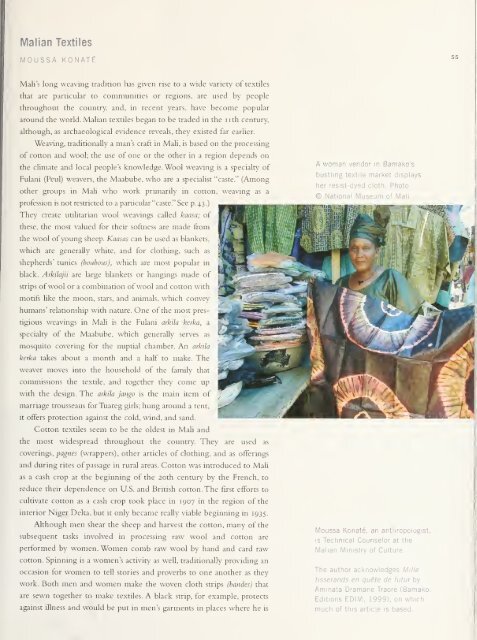SCOTLAND - Smithsonian Digital Repository - Smithsonian Institution
SCOTLAND - Smithsonian Digital Repository - Smithsonian Institution
SCOTLAND - Smithsonian Digital Repository - Smithsonian Institution
You also want an ePaper? Increase the reach of your titles
YUMPU automatically turns print PDFs into web optimized ePapers that Google loves.
Malian Textiles<br />
MOUSSA KONATt<br />
55<br />
Mali's long weaving tradition has given rise to a wide variety of textiles<br />
that are particular to communities or regions, are used by people<br />
throughout the country, and, in recent years, have become popular<br />
around the world. Malian textiles began to be traded in the nth century,<br />
although, as<br />
archaeological evidence reveals, they existed far earlier.<br />
Weaving, traditionally a man's craft in Mali, is based on the processing<br />
of cotton and wool; the use of one or the other in a region depends on<br />
the cUmate and local people's knowledge. Wool weaving is a specialty of<br />
Fulani (Peul) weavers, the Maabube, who are a specialist "caste." (Among<br />
other groups in Mah who work primarily in cotton, weaving as a<br />
profession is not restricted to a particular "caste." See p. 43 .)<br />
A woman vendor in Bamako's<br />
bustling textile market displays<br />
her reslst-dyed cloth.<br />
Photo<br />
© National Museum of Mali<br />
They create utihtarian wool weavings called kaasa; of<br />
these, the most valued for their softness are made from<br />
the wool of young sheep. Kaasas can be used as blankets,<br />
which are generally white, and for clothing, such as<br />
shepherds' tunics (boubous), which are most popular in<br />
black. Arkilajii are large blankets or hangings made ot<br />
strips of wool or a combination of wool and cotton witli<br />
motifs Uke the moon, stars, and animals, which convey<br />
humans' relationship with nature. One of the most prestigious<br />
weavings in Mali is the Fulani arkila kerka, a<br />
specialty of the Maabube, which generally serves as<br />
mosquito covering for the nuptial chamber. An arkila<br />
kerka takes about a month and a half to make. The<br />
weaver moves into the household of the family that<br />
commissions the textile, and together they come up<br />
with the design. The arkila jango is the main item of<br />
marriage trousseaus for Tuareg girls; hung around a tent,<br />
it<br />
offers protection against the cold, wind, and sand.<br />
Cotton textiles seem to be the oldest in Mali and<br />
the most widespread throughout the country. They are used as<br />
coverings, pa^KM (wrappers), other articles of clothing, and as offerings<br />
and during rites of passage in rural areas. Cotton was introduced to Mali<br />
as a cash crop at the beginning of the 20th century by the French, to<br />
reduce their dependence on U.S. and British cotton. The first efforts to<br />
cultivate cotton as a cash crop took place in 1907 in the region of the<br />
interior Niger Delta, but it only became really viable beginning in 1935.<br />
Although men shear the sheep and harvest the cotton, many of the<br />
subsequent tasks involved in processing raw wool and cotton are<br />
performed by women. Women comb raw wool by hand and card raw<br />
cotton. Spinning is a women's activity as well, traditionally providing an<br />
occasion for women to teU stories and proverbs to one another as they<br />
work. Both men and women make the woven cloth strips<br />
(bandes) that<br />
are sewn together to make textiles. A black strip, tor example, protects<br />
against illness and would be put in men's garments in places where he is<br />
Moussa Konate, an anthropologist,<br />
is<br />
Technical Counselor at the<br />
Malian Ministry of Culture.<br />
The author acknowledges Mille<br />
tisserands en quite de futur by<br />
Aminata Dramane Traore (Bamako:<br />
Editions EDIM, 1999), on which<br />
much of this article is based.
















